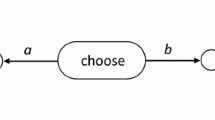Abstract
The formalism of abstracted quantum mechanics is applied in a model of the generalized Liar Paradox. Here, the Liar Paradox, a consistently testable configuration of logical truth properties, is considered a dynamic conceptual entity in the cognitive sphere (Aerts, Broekaert, & Smets, [Foundations of Science 1999, 4, 115–132; International Journal of Theoretical Physics, 2000, 38, 3231–3239]; Aerts and colleagues[Dialogue in Psychology, 1999, 10; Proceedings of Fundamental Approachs to Consciousness, Tokyo ’99; Mind in Interaction]. Basically, the intrinsic contextuality of the truth-value of the Liar Paradox is appropriately covered by the abstracted quantum mechanical approach. The formal details of the model are explicited here for the generalized case. We prove the possibility of constructing a quantum model of the m-sentence generalizations of the Liar Paradox. This includes (i) the truth–falsehood state of the m-Liar Paradox can be represented by an embedded 2m-dimensional quantum vector in a (2m)m-dimensional complex Hilbert space, with cognitive interactions corresponding to projections, (ii) the construction of a continuous ‘time’ dynamics is possible: typical truth and falsehood value oscillations are described by Schrödinger evolution, (iii) Kirchoff and von Neumann axioms are satisfied by introduction of ‘truth-value by inference’ projectors, (iv) time invariance of unmeasured state.
Similar content being viewed by others
References
D. Aerts (1982) ArticleTitleDescription of Many Physical Entities Without the Paradoxes Encountered in Quantum Mechanics Foundations of Physics 12 1131–1170 Occurrence Handle10.1007/BF00729621
D. Aerts (1983a) ArticleTitleClassical Theories and Non Classical Theories as a Special Case of a More General Theory Journal of Mathematical Physics 24 2441–2453 Occurrence Handle10.1063/1.525626
Aerts, D.: 1983b, The Description of One and Many Physical Systems. In C. Gruber (eds.), Foundations of Quantum Mechanics. Lausanne: A.V.C.P.63–148
D. Aerts (1986) ArticleTitleA Possible Explanation for the Probabilities of Quantum Mechanics Journal of Mathematical Physics 27 202–210 Occurrence Handle10.1063/1.527362
D. Aerts (1992) ArticleTitleThe Construction of Reality and its Influence on the Understanding of Quantum Structures International Journal of Theoretical Physics 31 1815–1837 Occurrence Handle10.1007/BF00678294
D. Aerts (1994) ArticleTitleQuantum Structures, Separated Physical Entities and Probability Foundations of Physics 24 1227–1259 Occurrence Handle10.1007/BF02148566
D. Aerts (1999) ArticleTitleFoundations of Quantum Physics: A General Realistic and Operational Approach International Journal of Theoretical Physics 38 289–358 Occurrence Handle10.1023/A:1026605829007
Aerts, D., J. Broekaert and L. Gabora (1999). Nonclassical Contextuality in Cognition: Borrowing From Quantum Mechanical Approaches to Indeterminism and Observer Dependence, Dialogues in Psychology 10.
Aerts, D., J. Broekaert and L. Gabora (2000). Intrinsic Contextuality as the Crux of Consciousness. In K. Yasue, M. Jibu and T. Della Senta (eds.), Proceedings of Fundamental Approaches to Consciousness, Tokyo ’99. Amsterdam: John Benjamins Publishing Company.
Aerts, D., J. Broekaert and L. Gabora (2002). A Case for Applying an Abstracted Quantum Formalism to Cognition. In M.H. Bickhard and R.L. Campbell (eds.), Mind in Interaction. Amsterdam: John Benjamins Publishing Company.
Aerts, D., J. Broekaert and S. Smets (1999). The Liar-Paradox in a Quantum Mechanical Perspective, Foundations of Science 4:115–132. Preprint at http://arxiv.org/abs/quant-ph/0007047.
Aerts, D., J. Broekaert and S. Smets (2000). A Quantum Structure Description of the Liar-Paradox, International Journal of Theoretical Physics 38:3231–3239. Preprint at http://arxiv.org/abs/quant-ph/0106131.
Pitowsky, I. (1989). Quantum Probability-Quantum Logic. Lecture Notes in Physics, vol. 321: Wien: Springer-Verlag.
Author information
Authors and Affiliations
Corresponding author
Rights and permissions
About this article
Cite this article
Broekaert, J., Aerts, D. & D’Hooghe, B. The Generalised Liar Paradox: A Quantum Model and Interpretation. Found Sci 11, 399–418 (2006). https://doi.org/10.1007/s10699-004-6248-8
Issue Date:
DOI: https://doi.org/10.1007/s10699-004-6248-8



